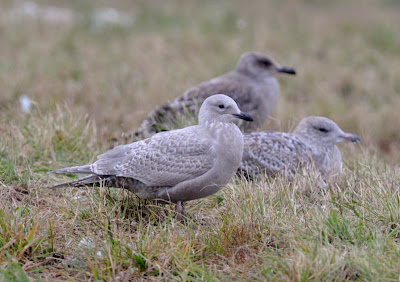Juv. Sabine's Gull at Whitefish Point-Dave Bell
At the Dafter Landfill yesterday I had an adult Thayer's Gull along with a juv. bird that was light enough to be a Kumlien's- but something about the plumage made me think this bird was probably a Kumlien's -Thayer's intergrade.
Adult Thayer's Gull
Adult Thayer's Gull (back bird)
This bird has yet to develop the dark hood seen in most adult winter Thayer's. The dark eye is apparent but this is not diagnostic as probably about 1 in 250 adult Herrings will have a dark eye. The occasional full fledged Thayer's will have a light eye. I had at least 3 distinctly dark-eyed Herrings today. The wing pattern is diagnostic for Thayer's. In Thayer's in a resting position you can often see the white underside of P10. In the Herring you can often see the P10 mirror immediately eliminating Thayer's.
Adult Herring Gull -showing large mirror on underside of incoming P10
Adult winter Thayer's Gull-showing white underside P10
Several times I have noted an adult Herring Gull with a dark eye and subsequently noted the other eye was light. The dark eye clearly having been lost in some dispute or accident. These birds can often be recognized as they are constantly moving there heads back and forth in compensation for there lost eye.
Adult Herring Gull -dark eye secondary to injury?
Same adult Herring Gull-light healthy eye
I probably see at least one legitimately dark- eyed adult Herring Gull per visit to the landfill. Note the
difference between the injured dark eye which is very black looking like a black hole and the healthy dark eye which still reflects light and with a good view the pupil can be seen. This difference can be seen fairly easily in the field.

Adult Herring Gull-dark eye variant
Adult Herring Gull-dark eyed variant
Here is the juvenile Kumlien's- like gull. Although the bird appears to be generally light enough to be a Kumlien's I am suspicious this is more likely to be a Kumlien's-Thayer's intergrade. The relatively solid tertials and the uniform brownish colour would be unusual for a pure Kumlien's which is usually fairly speckled looking with a white ground colour.
Juvenile Kumlien's-Thayer's Gull intergrade
Juvenile Kumlien's Gull
Another Thayer's Gull I had the other day was a bit different. This was bird molting into second basic plumage. Usually by the time Thayer's gulls get here they have mostly completed their molt. Often P10 isn't quite fully grown in but that would be about the extent of molt left to be completed. Olsen and Larsson suggest that Thayer's molt into second basic plumage between March and early September.
Thayer's Gull molting into second winter plumage
This bird has P9 still growing in and P10 is just starting. The inner secondaries and coverts are old and worn. The bill has yet to become bicolored. This bird clearly had an injured left foot. I am not sure if this somehow has delayed the molt? I don't ever recall an arctic gull arriving in this partially molted condition. I wonder if the bird might have summered locally given its injury?
My first adult Glaucous Gull of the season popped up today. The interesting thing was it was banded. It had a silver band (..767..) on the left leg and a blue band with -A9- on the right leg.
Adult Glaucous Gull with bands
This would appear to be a great opportunity to see were the Glaucous Gulls that pass through our area every fall originate. If any one is aware of who may be banding Glaucous Gulls please let me know.
Right leg band Glaucous Gull
Left leg band Glaucous Gull
The silver band has some writing on it which is not quite decipherable-the numbers "767" can be seen.
If any one has information or knows how I can find out where or who banded this bird please E-mail me.
zufelt_k@shaw.ca
Kirk Zufelt
















Hi Kirk:
ReplyDeleteThis could be a Norwegian bird; you can try it with Halvard Strom from Norwegian Polar Institute:
Hallvard.strom@npolar.no
Best wishes
Antonio
I would check with Chip Weseloh on band provenance.
ReplyDeleteYou might be interested in this:
http://www.flickr.com/groups/505232@N24/
Hi, this is at least not an Stavanger Museum ring, neither an Zoological Museum Oslo ring, ie it is not ringed in Norway or Spitsbergen.
ReplyDeleteAll the best,
Morten Helberg
you should contact the bird banding office (CWS) about your banded GLGU.
ReplyDeleteThe 767 looks like it would be the prefix band number. I can see a "-" just after the last 7. Great photos
The USGS Bird Banding Lab has info about this bird. You should report it at www.reportband.gov.
ReplyDeleteInteresting readd
ReplyDelete